Old Boys Features
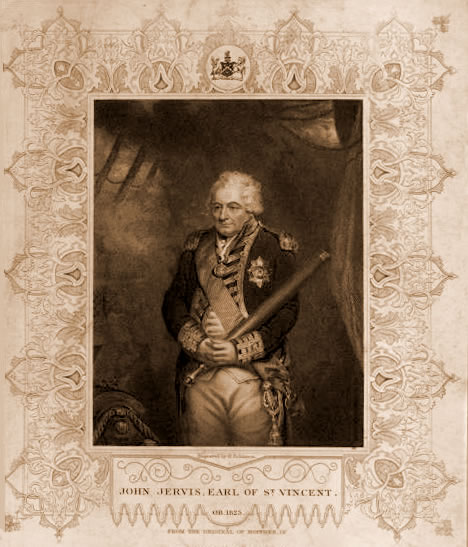
Select item to view:
 |
|

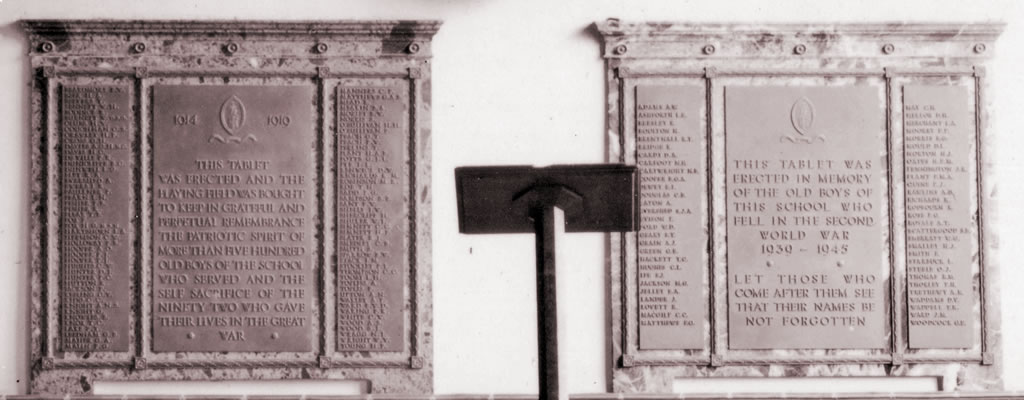
The two Memorial Tablets were situated in the Main Hall at Bond Street School. In the move to the new school in Winshill, they were positioned in the foyer where they remained during the whole time as a Grammar School.
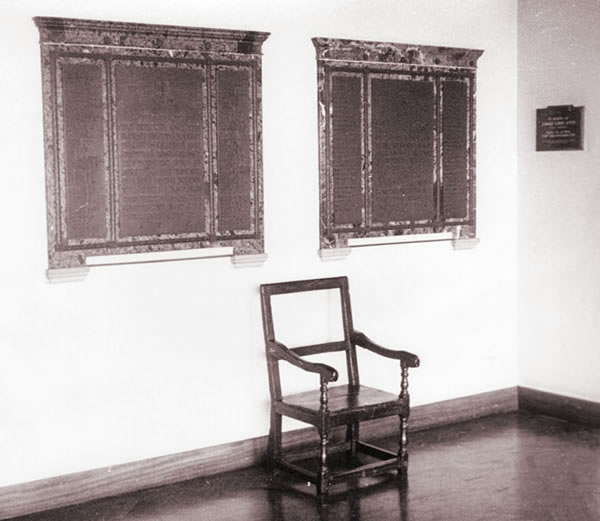
They may still been seen in the current school inside the Main Hall.
WWI Tablet
THIS TABLET WAS ERECTED AND THE PLAYING FIELD WAS BOUGHT TO KEEP IN GRATEFUL AND PERPETUAL REMEMBRANCE THE PATRIOTIC SPIRIT OF MORE THAN FIVE HUNDRED OLD BOYS OF THE SCHOOL WHO SERVED AND THE SELF SACRIFICE OF THE NINETY TWO WHO GAVE THEIR LIVES IN THE GREAT WAR
|
WWI TABLET NAMES |
||
| Beardmore, B. W. | Hughes, C. W. | Robinson, M. R. |
| Beer, H. A. | Hunter, D. J. | Roe, T. H. |
| Beevers, T. | Hunter, P. C. | Sadd, P. G. |
| Bennen, W. H. | Hutton, R. | Sampson, S. E. |
| Boddice, R. | Jackson, F. | Sant, F. W. |
| Burnett, W. (D.S.O.) | Keeling, C. V. | Shelley, J. W. |
| Clubb, H. W. | Kidd, C. C. | Shercliff, H. |
| Couchman, C. S. | Knight, A. N. S. | Shuker, W. J. |
| Crawley, H. F. | Knight, G. | Simnett, C. C. |
| Cross, G. H. | Knowles, E. | Simnett, H. F. |
| Davies, A. G. H. (M.C.) | Knox, T. C. | Slater, R. J. |
| Davis, H. C. | Lake, T. C. | Smedley, C. B. |
| De Ville, P. R. | Leedham, G. E. | Smith, S. |
| Dunnicliffe, E. C. | Maher, G. A. | Sparrow, E. W. |
| Dunwell, L. G. | Malin, F. G. | Stack, J. M. |
| Eley, R. A. | Manners, C. F. | Stockley, P. L. |
| Evershed, A. | Matthew, G. A. | Thompson, C. C. |
| Ewers, L. R. | Mead, E. | Tooby, L. H. |
| Faulkner, P. | Meakin, S. A. | Topliss, A. |
| Fearn, L. N. | Morley, E. W. | Toplis, F. |
| Fisher, F. B. | Norris, S. | Upton, A. N. |
| Fisher, R. | O’Sullivan, H. H. | Wakley, A. P. |
| Flear, T. E. | O’Sullivan, F. | Ward, E. W. D. |
| Fox, F. | Peach, G. T. | Waring, R. R. |
| Fox, H. G. C. (M.S.M.) | Peach P. W. | White, C. W. |
| Hartshorn, L. A. | Perkins, T. | Wood, A. S. |
| Herbison, C. W. | Plant, H. A. B. | Wood, S. J. |
| Holloway, F. B. | Potts, G. T. L. | Wragg, N. J. |
| Hooper, A. O. | Pye, J. L. | Wright, W. V. |
| Hooper, F. J. | Renwick, D. W. | Young, H. F. |
| Hooper, P. J. | Richards, R. M. | |
To see the complete WWI Roll of Honour, Click Here
WWII Tablet
THIS TABLET WAS ERECTED IN MEMORY OF THE OLD BOYS OF THIS SCHOOL WHO FELL IN THE SECOND WORLD WAR 1939 – 1945
+ + +
LET THOSE WHO COME AFTER THEM SEE THAT THEIR NAMES BE NOT FORGOTTEN
|
WWII TABLET NAMES |
||
| Adams A.W. | Hackett T.C. | Quine P.J. |
| Ashford L.E. | Hughes C.L. | Rawlins A.G. |
| Beesley R. | Ife S.J. | Richards R. |
| Boulton H. | Jackson M.G. | Rodbourn K. |
| Brentnall K.T. | Jelley E.A. | Rose P.G. |
| Bridge R. | Lander J. | Royals A.T. |
| Cardy D.A. | Lovett R. | Scattergood S.B. |
| Carfoot N.H. | MacGilp C.C. | Sherratt W.B. |
| Cartwright N.B. | Matthews F.G. | Smalley H.J |
| Cooper B.G.A. | May C.H. | Smith F. |
| Dewey E.I | Mellor D.H. | Starbuck L. |
| Douglas C.B. | Merchant L.A. | Steele O.J. |
| Eaton A. | Moorby F.P. | Thomas R.M. |
| Evershed S.J.A. | Morris E.G. | Thorley T.H. |
| Evison P. | Mould D.L. | Trethewey A.R. |
| Ford W.D. | Norton H.J. | Waddams D.V |
| Geary S.J. | Oates H.F.M. | Waddell T.R |
| Grain A.J. | Pennington J.R. | Ward J.M. |
| Green G.E. | Plant F.M.A. | Woodcock G.E. |
To see more details of the WWII Roll of Honour, Click Here

The Roll of Honour lists around 500 Burton Grammar School ex-pupils together with their Unit, Rank and Fate making a poignant record of the times. It is, of course, refered to at the time as the 1914-1918 European War since only unfolding history would be able to later label it as WW I.
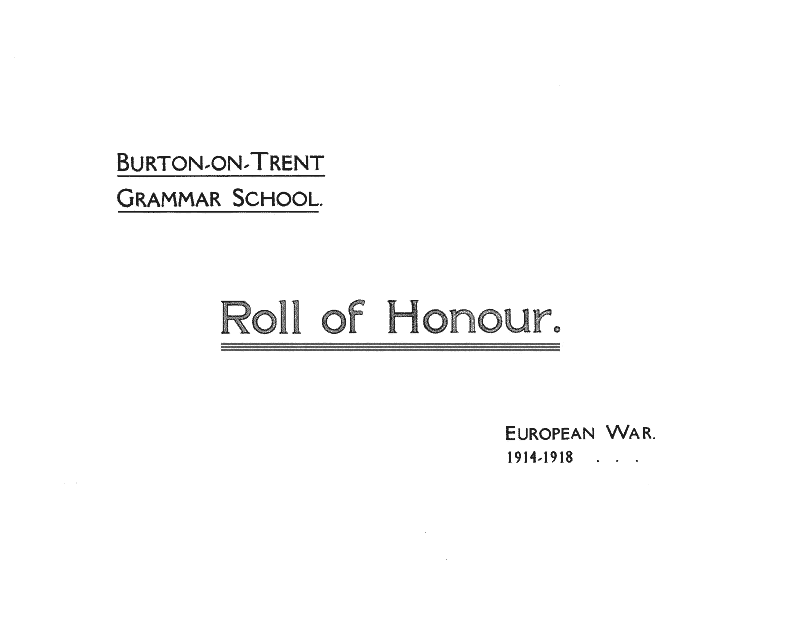
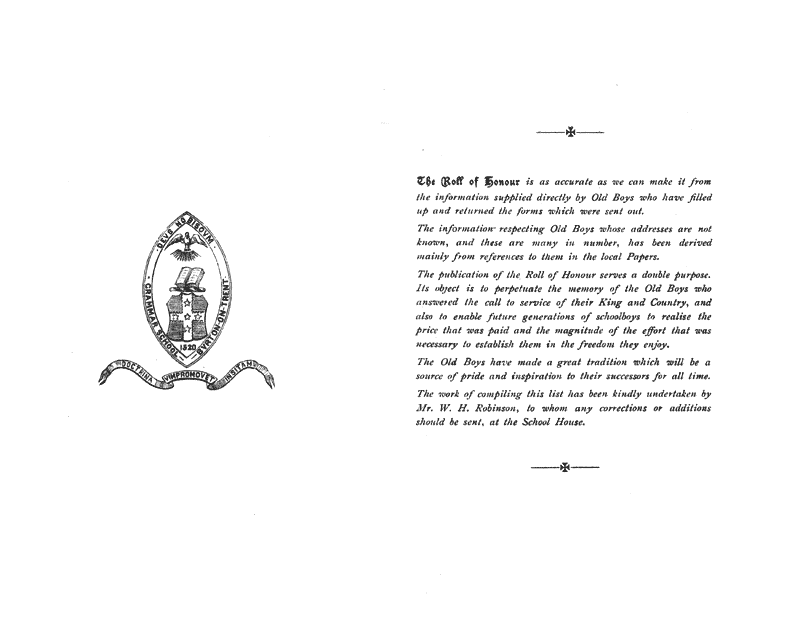
The Roll of Honour is as accurate as we can make it from, the information supplied directly by Old Boys who have filled up and returned the forms which were sent out.
The information respecting Old Boys whose addresses are not known, and these are many in number, has been derived mainly from references to them in the local Papers.
The publication of the Roll of Honour serves a double purpose. Its object is to perpetuate the memory of the Old Boys who answered the call to service of their King and Country, and also to enable future generations of schoolboys to realise the price that was paid and the magnitude of the effort that was necessary to establish them in the freedom they enjoy.
The Old Boys have made a great tradition which will be a source of pride and inspiration to their successors for all time.
The work of compiling this list has been kindly undertaken by Mr. W. H. Robinson, to whom any corrections or additions should be sent, at the School House.
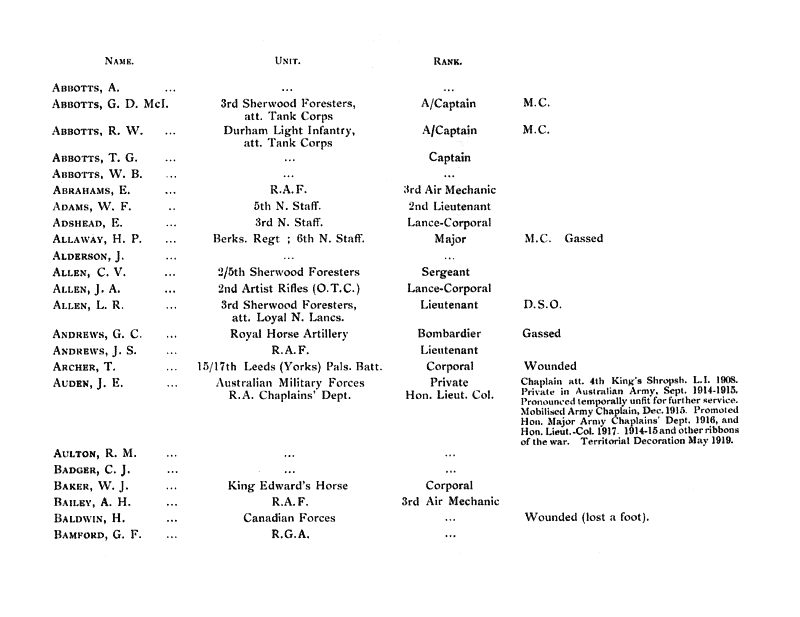
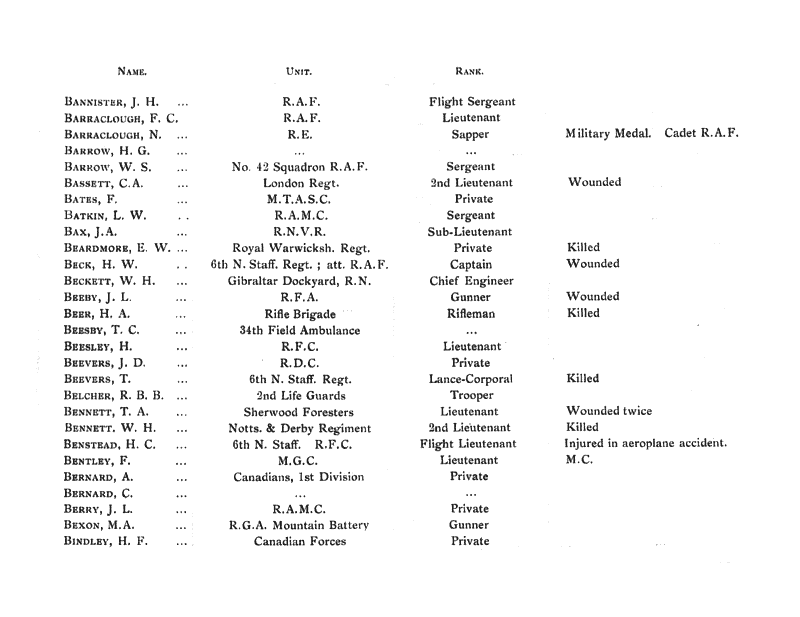
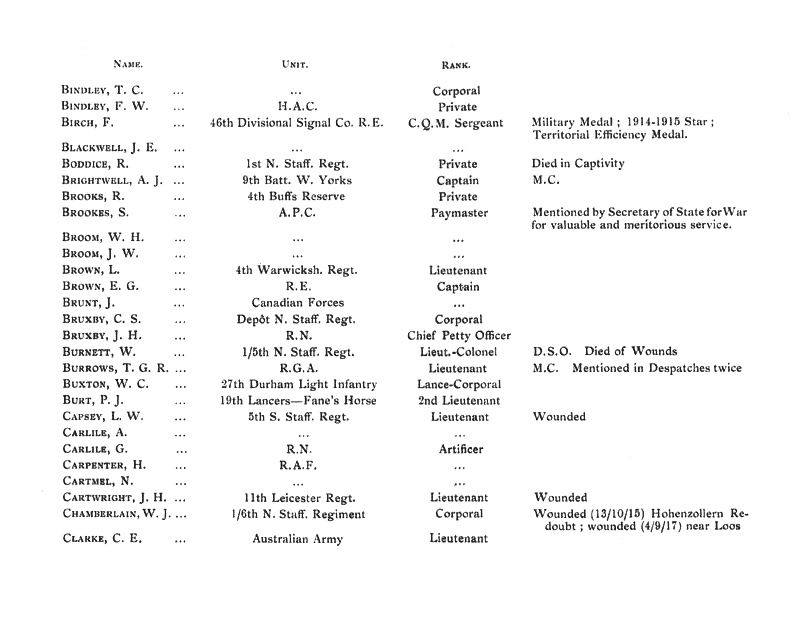
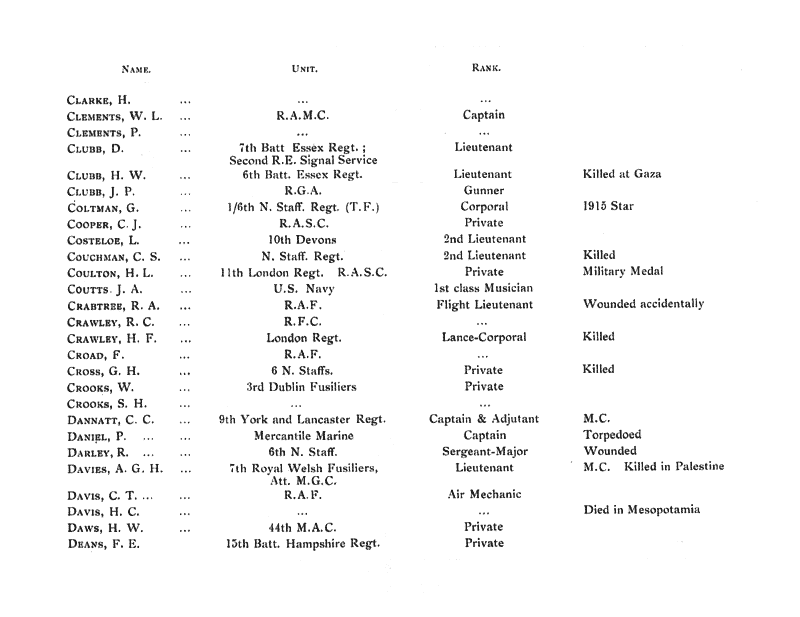
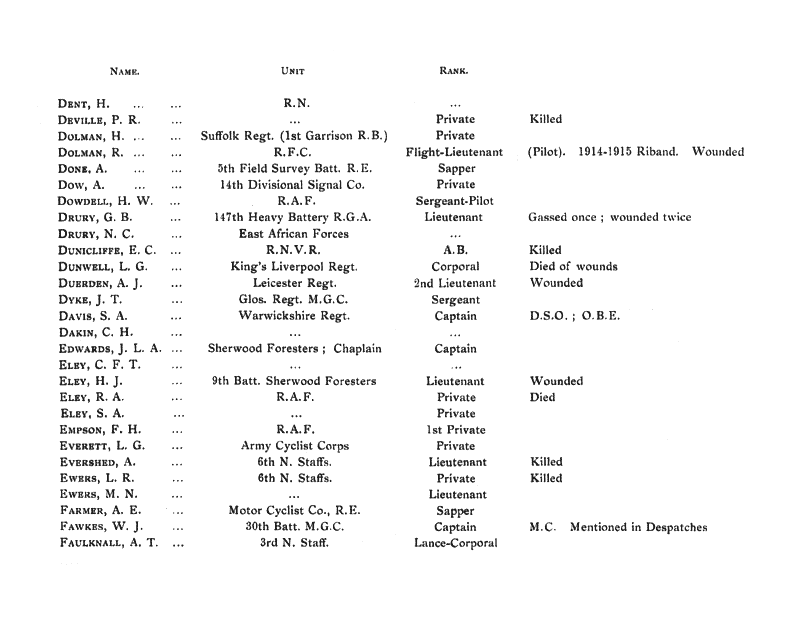
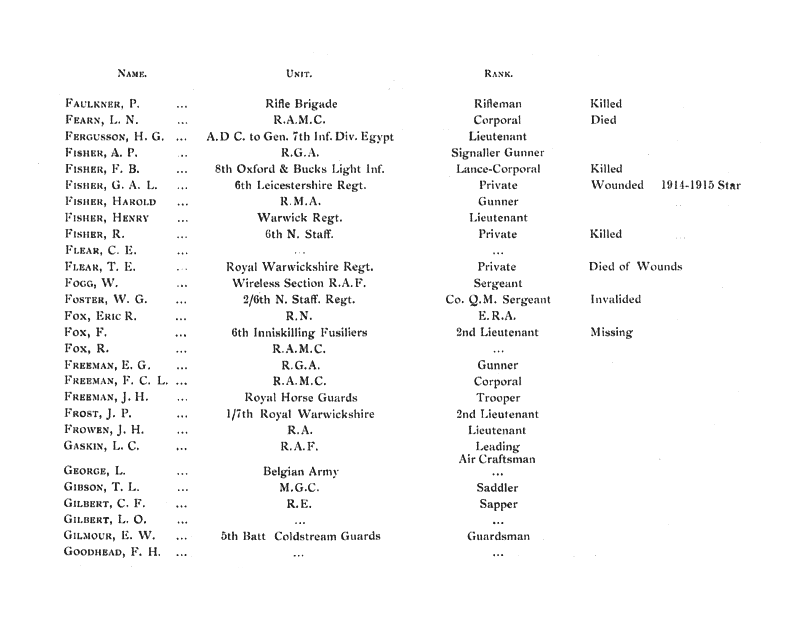
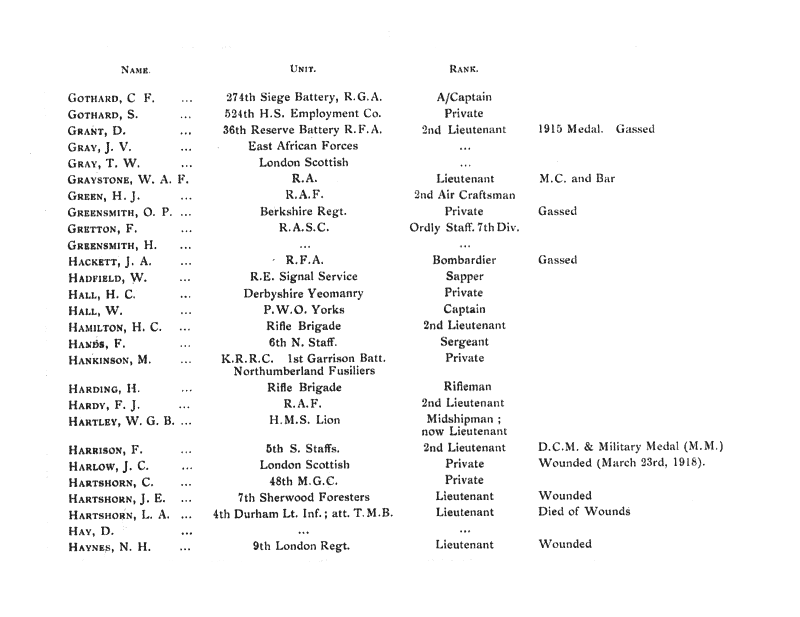
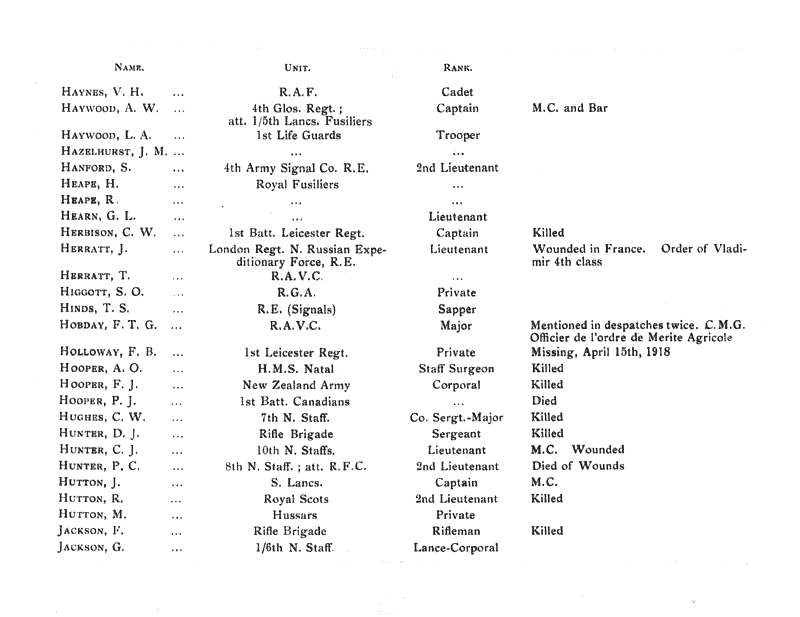
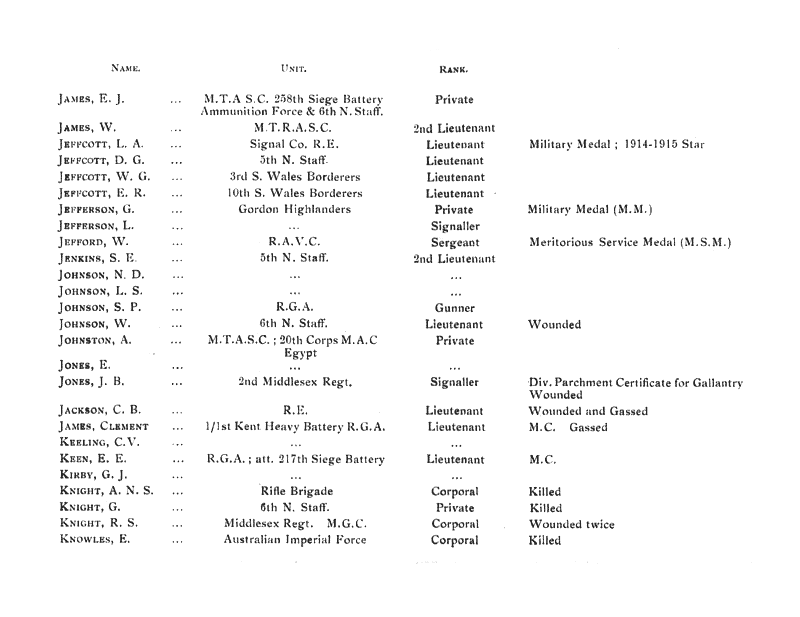
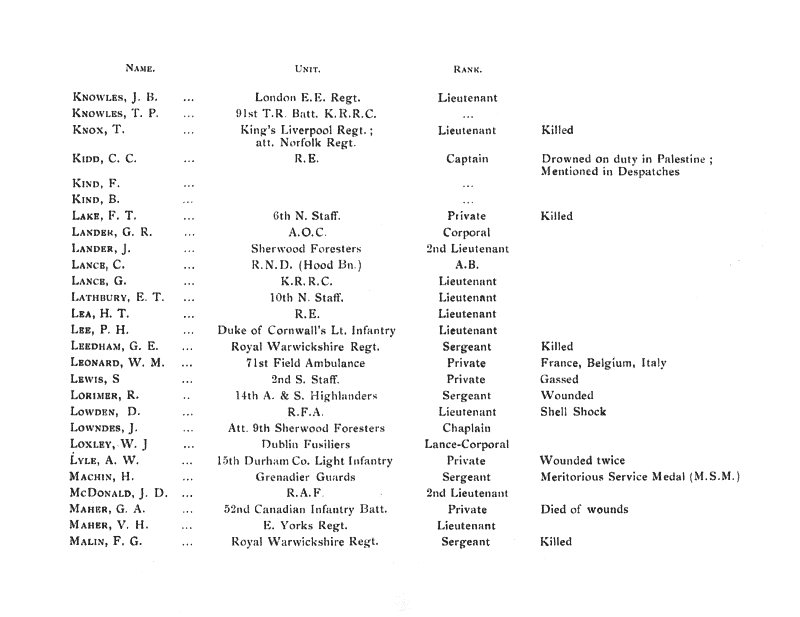
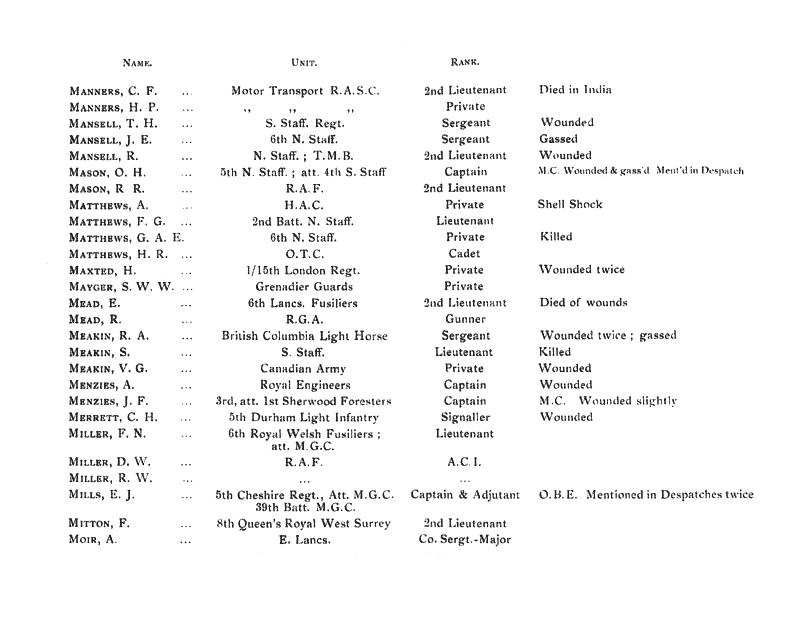
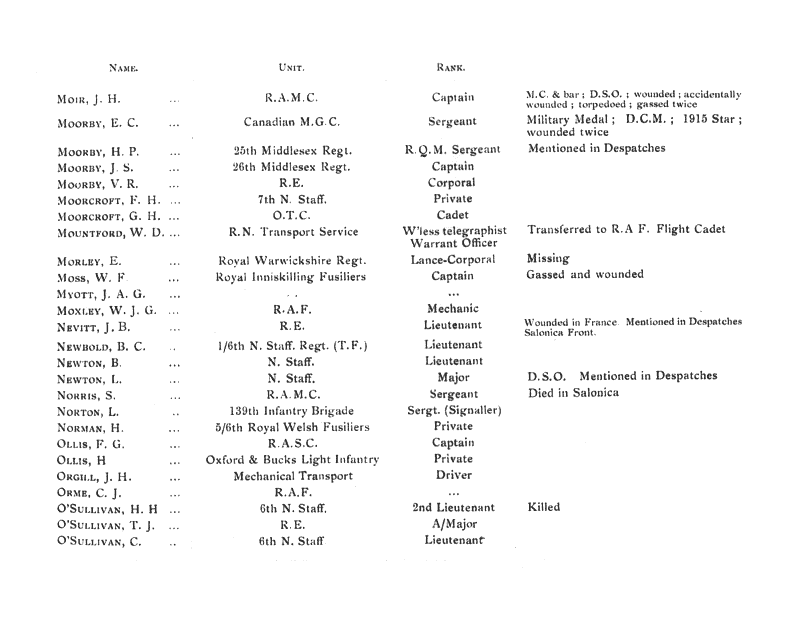
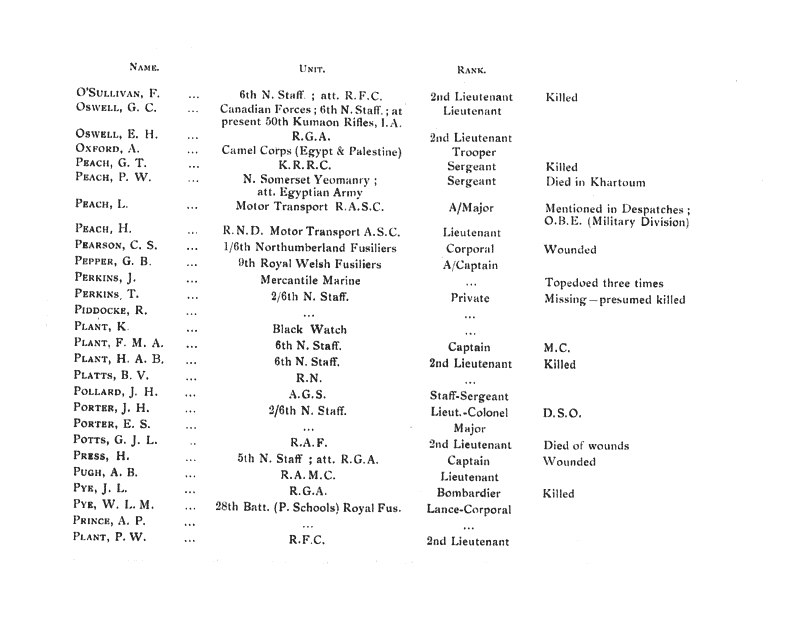
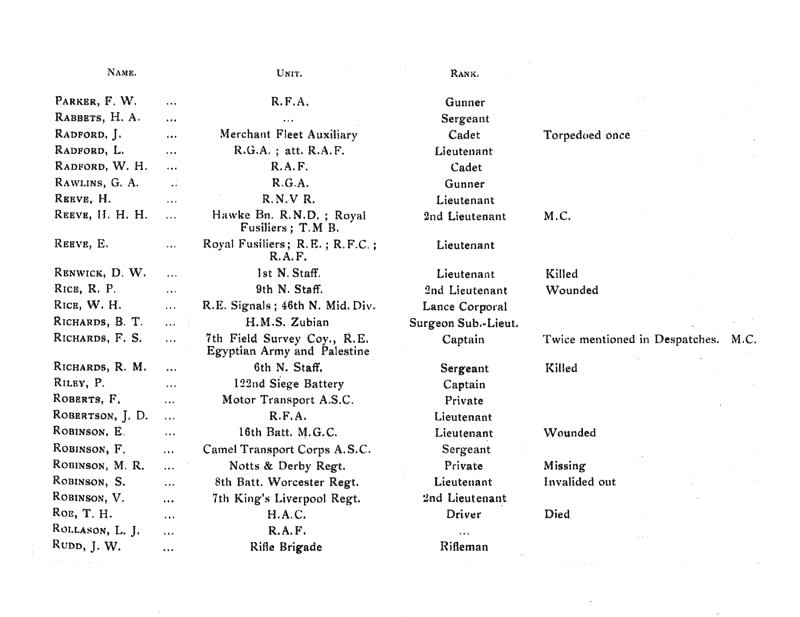
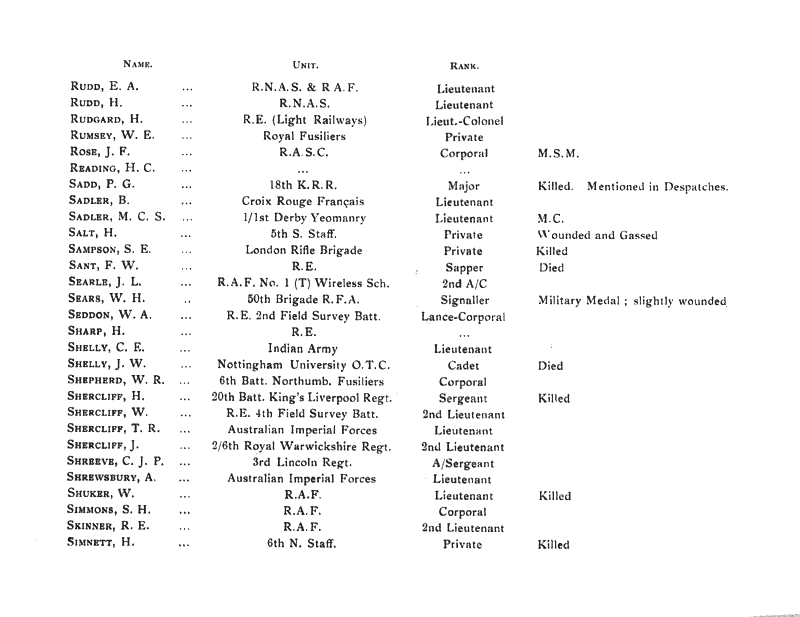
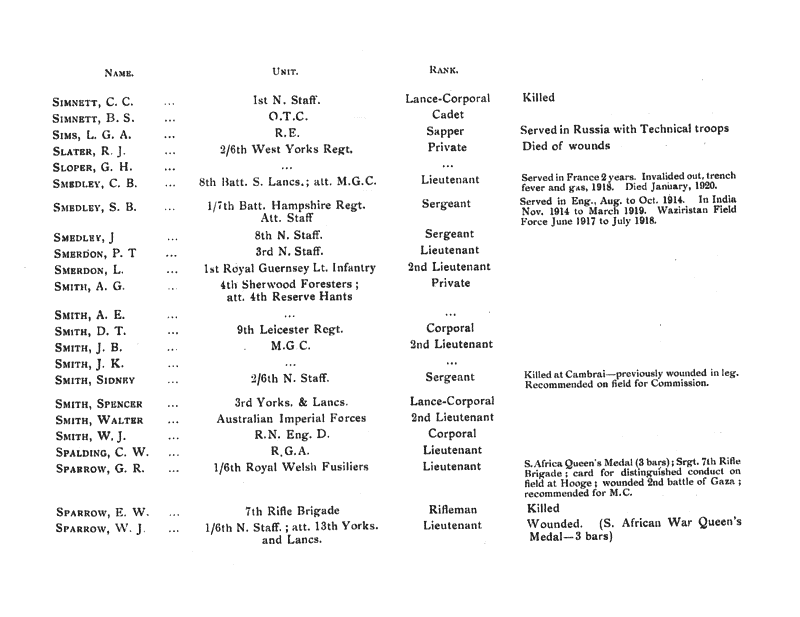
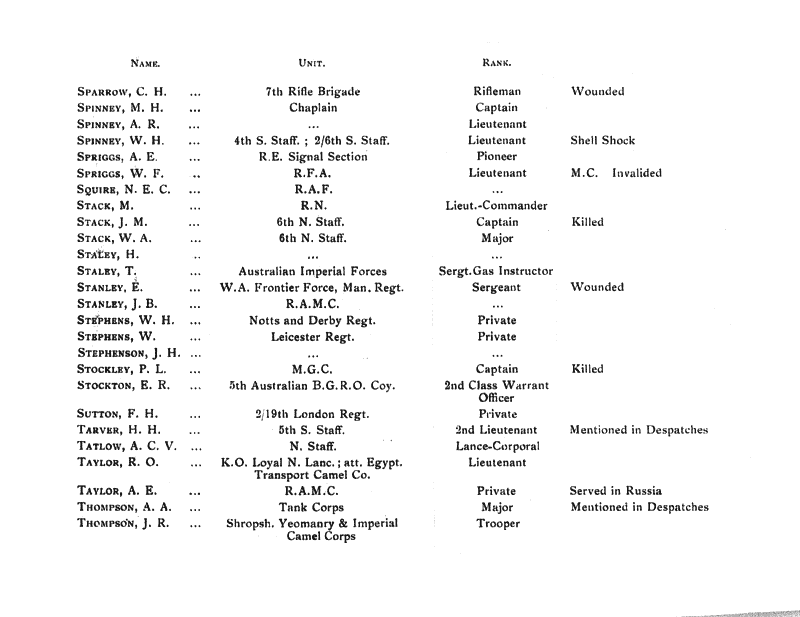
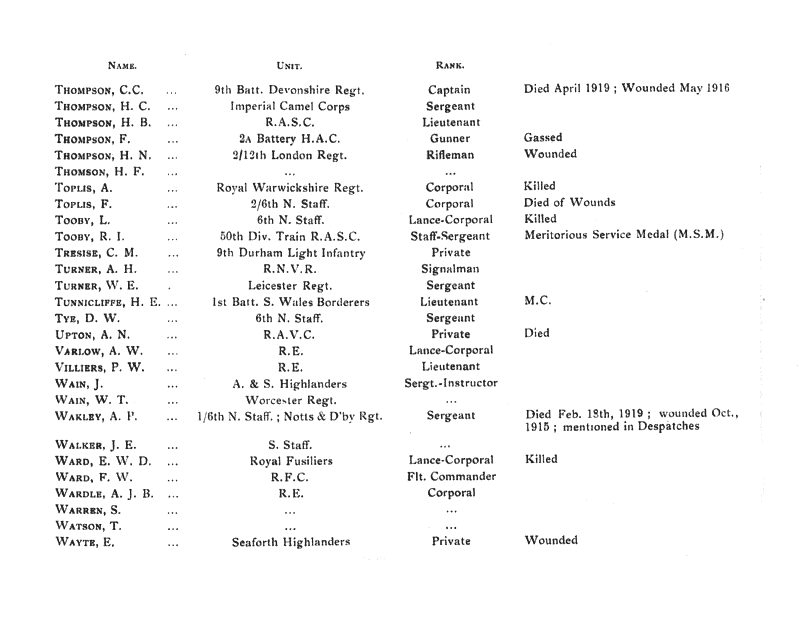
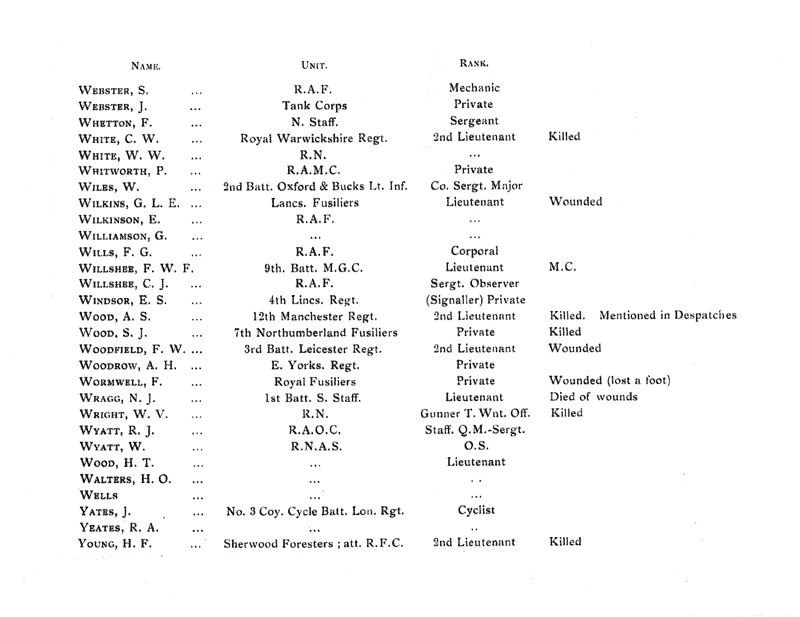
Abbotts; Abrahams; Adams; Adshead; Allaway; Alderson; Allen; Andrews; Archer; Auden; Aulton; Badger; Baker; Bailey; Baldwin; Bamford; Bannister; Barraclough; Bakrow; Barrow, Bassett; Bates; Batkin; Bax; Beardmore; Beck; Beckett; Beeby; Beer; Beesby; Beesley; Beevers; Belcher; Bennett; Benstead; Bentley; Bernard; Berry; Bexon; Bindley; Birch; Blackwell; Boddice; Brightwell; Brooks; Brookes; Broom; Brown; Brunt; Bruxby; Burnett; Burrows; Buxton; Burt; Capsey; Carlile; Carpenter; Cartmel; Cartwright; Chamberlain; Clarke; Clements; Clubb; Coltman; Cooper; Costeloe; couchman; Coulton; Coutts; Crabtree; Crawley; Croad; Cross; Crooks; Dannatt; Daniel; Darley; Davies; Davis; Daws; Deans; Dent; Deville; Dolman; Done; Dow; Dowdell; Drury; Dunicliffe; Dunwell; Duerden; Dyke; Davis; Dakin; Edwards; Eley; Empson; Everett; Evershed; Ewers; Farmer; Fawkes; Faulknall; Faulkner; Fearn; Fergusson; Fisher; Flear; Fogg; Foster; Fox; Freeman; Frost; Frowen; Gaskin; George; Gibson; Gilbert; Gilmour; Goodhead; Gothard; Grant; Gray; Graystone; Green; Greensmith; Gretton; Hackett; Hadfield; Hall; Hamilton; Hands; Hankinson; Harding; Hardy; Hartley; Harrison; Harlow; Hartshorn; Hay; Haynes; Haywood; Hazelhurst; Hanford; Heape; Hearn; Herbison; Herratt; Higgott; Hinds; Hobday; Holloway; Hooper; Hughes; Hunter; Hutton; Jackson; James; Jeffcott, Jefferson; Jefford; Jenkins; Johnson; Johnston; Jones, Jackson; James; Keeling; Keen; Kirby; Knight; Knowles; Knox, Kidd, Kind; Lake; Lander; Lance; Lathbury; Lea; Lee; Leedham; Leonard; Lewis; Lorimer; Lowden; Lowndes; Loxley; Lyle; Machin; McDonald; Maher; Malin; Manners; Mansell; Mason; Matthews; Maxted; Mayger; Mead; Meakin; Menzies; Merrett; Miller; Mills; Mitton; Moir; Moorby, Moorcroft; Mountford; Morley; Moss; Mycott; Moxley; Nevitt; Newbold; Newton; Norris; Norton; Norman; Ollis; Orgill; Orme; O’Sullivan; Oswell; Oxford; Peach; Pearson; Pepper; Perkins; Piddocke; Plant; Platts; Pollard; Porter; Potts; Press; Pugh; Pye; Prince; Plant; Parker; Rabbets; Radford; Rawlins; Reeve; Renwick; Rice; Richards; Riley; Roberts; Robertson; Robinson; Roe; Rollanson; Rudd; Rudgard; Rumsey; Rose; Reading; Sadd; Sadler; Salt; Sampson; Sant; Searle; Sears; Seddon; Sharp; Shelly; Shepherd; Shercliff; Shreeve; Shrewsbury; Shuker; Simmons; Skinner; Simnett; Sims; Slater; Sloper; Smedley; Smerdon; Smith; Spalding; Sparrow; Spinney, Spriggs; Squire; Stack; Staley; Stanley; Stephens; Stephenson; Stockley; Stockton; Sutton; Tarver; Tatlow; Taylor; Thompson; Toplis; Topliss; Tooby; Tresise; Turner; Tunnicliffe; Tye; Upton; Varlow; Villiers; Wain, Wakley; Walker; Walters; Ward; Wardle; Warren; Watson; Wayte; Webster; Wells; Whetton; White; Whitworth; Wiles; Wilkins; Wilkinson; Williamson; Wills; Willsher; Windsor; Wood; Woodfield; Woodrow; Wormwell; Wragg; Wright; Wyatt; Yates; Yeates; Young;

Fifty-seven names are recorded on the WWII Memorial Tablet in memory and honour of Old Boys of the school who fell in the Second World War.
Mr E.J. ‘Boz’ Hathaway, who attended Burton Grammar school from 1934 to 1941 went to some considerable lengths to trace everyone featured.
The result of his research can be seen below:
| Surname | Forenames | School Years | Rank | Fate | |
| ADAMS | Anthony Wallace | (1931-36) | Flt/Lt. | Beaufighter crashed into sea 20.7.44 | |
| ASHFORD | Lewis Ernest | (1920-21) | Sgt. Pilot | Killed on training flight 1.9.40 | |
| BEESLEY | Ralph | (1912-15) | Flt/Lt. | Died on active service, buried in Iraq 1942 | |
| BOULTON | Harry | (1932-37) | Guardsman | Died of wounds; Buried at Anzio | |
| BRENTWALL | Kenneth T. | (1933-39) | Sgt. (RAF) | Killed over Germany in Lancaster 15/6.8.43 | |
| BRIDGE | Reginald | (1929-35) | Signalman | Prisoner in Japan; Died 27.2.44 | |
| CARDY | Dennis Alfred | (1932/33) | Sgt.(RAF) | Shot down in Wellington Bomber 12.8.43 | |
| CARFOOT | Norman Henry | (1931-40) | Flt/Lt. | Shot down over Germany 3.11.43 | |
| CARTWRIGHT | Norman Byng | (1929-31) | Sgt. Pilot | — | |
| COOPER | Bertram George Arthur | (1920-27) | Sgt. W/Op. | Shot down over France; Died 16.7.43 | |
| DEWEY | Eric Irwin | (1931-35) | Guardsman | Killed in Middle East 1943 | |
| DOUGLAS | Clifford Bennett | (1936-40) | Sgt. (Nav) | Shot down on first operation 26.2.45 | |
| EATON | Arthur | (1926-30) | Pilot Off. | Shot down off Spanish coast 19.8.42 | |
| EVERSHED | Sydney John Anthony | (1925-26) | Pilot Off. | Shot down over Dover 9.7.40 | |
| EVISON | Peter | (1930-33) | Sgt. Pilot | Shot down over Germany 3.3.43 | |
| FORD | Walter Douglas | (1929-39) | Private | Captured in Singapore; Died in Japanese hands | |
| GEARY | Stephen Tebbett | (1931-36) | Flt/Lt. | DFM Shot down attacking a submarine 1.5.44 | |
| GRAIN | Arthur James | (1927-33) | Flt/Lt. | Shot down over France 3.5.44 | |
| GREEN | George Eric | (1927-32) | Sgt.Nav. | Shot down in Blenheim 25.5.41 | |
| HACKETT | Thomas Charles | (1919-23) | Private | Killed on a march 18.10.40 | |
| HUGHES | Charles Laurie | (1919-23) | Lieut. | Mentioned in despatches; Killed in action, France 26.5.40 | |
| IFE | Stanley John | (1919-23) | Lieut. | Drowned, Minesweeper sunk off Normandy 10.7.44 | |
| JACKSON | Maurice George | (1931-37) | Sgt. Pilot | Shot down in Blenheim attack in France 21.5.41 | |
| JELLEY | Edward Arthur | (1918-21) | Pilot Off. | Killed on active service in air attack 30.9.40 | |
| LANDER | John | (1905-14) | Major | Killed In Sicily commanding Parach. Reg. 13.7.43 | |
| LOVETT | Roy | (1932-39) | Ord. Seaman | Killed in English Channel 3.12.42 | |
| MACGILP | Colin Campbell | (1917-24) | Major | Killed in action 1944 – Cassino | |
| MATTHEWS | Frederick George | (1908-14) | Major | Killed at Dunkirk 21.5.40 | |
| MAY | Charles Herbert | (1927-33) | Sgt. (RAF) | Killed in action at El Alamein 10.7.42 | |
| MELLOR | David Herbert | (1928-33) | 2nd, Lieut. | Killed in action Tank Regt. 22.11.41 | |
| MERCHANT | Leslie Arthur | (1920-23) | Flt/Sgt. | Missing in Hudson in Bay of Biscay 20.10.42 | |
| MOORBY | Frank Preston | (1926-30) | Pilot Officer | Killed in flying accident 26.9.43 | |
| MORRIS | Edward Gibson | (1916-23) | Bombardier | Killed in action R.A. 12.6.41 | |
| MOULD | Dennis Leonard | (1937-41) | Sgt. (RAF) | Crashed into sea on Liberator, Singapore 11.3.45 | |
| NORTON | Harry John | (1923-27) | Sgt. (RAF) | Killed in action Guards Div. France 27.5.40 | |
| OATES | Hector Frederick M. | (1939-49) | Private | Killed in action Bergen-op-Zoom 27.10.44 | |
| PENNINGTON | John Ray | (1926-32) | Fly/Off. | DFC Shot down in Lancaster in Holland 13.1.43 | |
| PLANT | Frederick Michael Arthur | Capt. M.C. | MC Killed on active service 7.8.42 aged 50 | ||
| QUINE | Peter John | (1930-33) | Gunner | Died on active service in Algeria 25.2.44 | |
| RAWLINS | Alexander George | (1931-38) | Sgt. (RAF) | Shot down in Wellington over Germany 12.6.43 | |
| RICHARDS | Robert | (1929-37) | Fly/Off. | Missing near Singapore 1.3.42 | |
| RODBOURN | Kenneth | (1933-39) | Pilot Officer | Shot down over France 16. 3. 44 | |
| ROSE | Peter Garrett | (1928-32) | Sgt. Pilot | Shot down over Belgium 3.5.41 | |
| ROYALS | Anthony Thomas | (1933-38) | Lance/Sgt. RAMC | Drowned in Palestine 14.7.46 | |
| SCATTERGOOD | Sydney Brian | (1925-30) | Lieut. | Died on active service; Egypt 26.11.41 | |
| SHERRATT | William George | (1931-36) | Sgt. (RAF) | Shot down in Wellington over France 29.4.42 | |
| SMALLEY | Herbert John | (1932-36) | Sgt. (RAF) | Shot down over Germany – Bavaria 16.1.45 | |
| SMITH | Frederick | (1931-35) | Sgt. (RAF) | DFM Killed in action – Pathfinders 17.4.43 | |
| STARBUCK | Leonard | (1927-34) | Sgt. (RAF) | Shot down over Germany 26.6.42 | |
| STEEL | Oliver J. | (1922-28) | Fireman AFS | Killed by enemy action London 6.11.40 | |
| THOMAS | Robert Mark | (1934-39) | Sgt. (RAF) | Shot down in Beaufighter Nr. Singapore 29.6.43 | |
| THORLEY | Thomas Henry | (1933-39) | Sgt. (RAF) | Shot down in Whitley over Germany 8.11.41 | |
| TRETHEWEY | Arthur Russell | (1918-20) | 3rd Engineer Off. | Killed at sea, Canadian Merchant Navy 29.7 43 | |
| WADDANS | Douglas Vincent | (1928-35) | Sgt. | Killed on active service 1943 | |
| WADDELL | Tom Ronaldson | (1930-31) | Private | Killed in action – Crete 2.6.41 | |
| WARD | John Montague | (1931-36) | Sgt.Pilot | Shot down whilst mine laying 22.11.40 | |
| WOODCOCK | George Edwin | (1932-39) | Flt/Sgt. | DFM Shot down in Beaufighter 18.12.42 | |
Legend:
DFM – Distinguished Flying Medal, awarded to RAF personnel below commissioned rank, for “an act or acts of valour, courage or devotion to duty whilst flying in active operations against the enemy”.
DFC – Distinguished Flying Cross, awarded to RAF officers, for “an act or acts of valour, courage or devotion to duty whilst flying in active operations against the enemy”.
MC – Military Cross, awarded to Army officers in recognition of “an act or acts of exemplary gallantry during active operations against the enemy on land”.
RAMC – Royal Army Medical Corps.
AFS – Army Fire Service
The original pages:
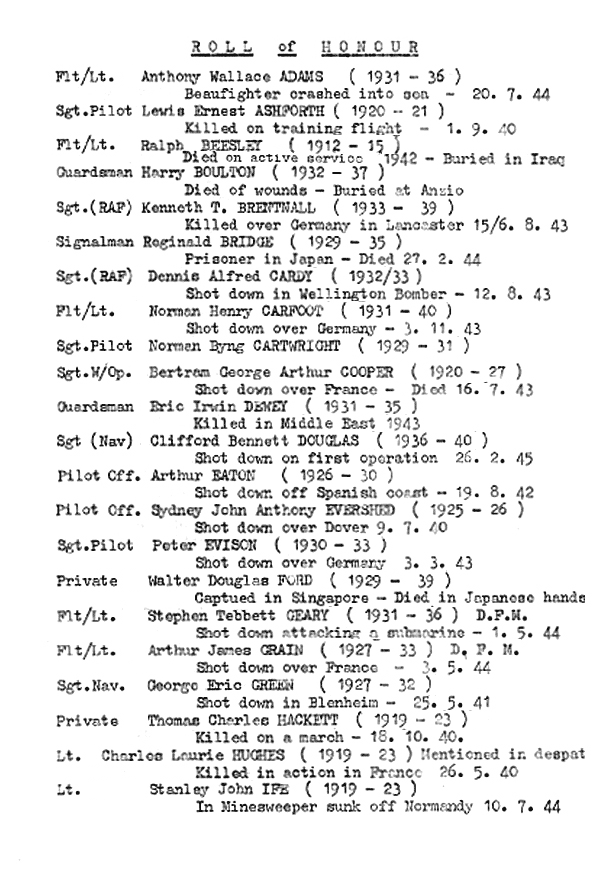
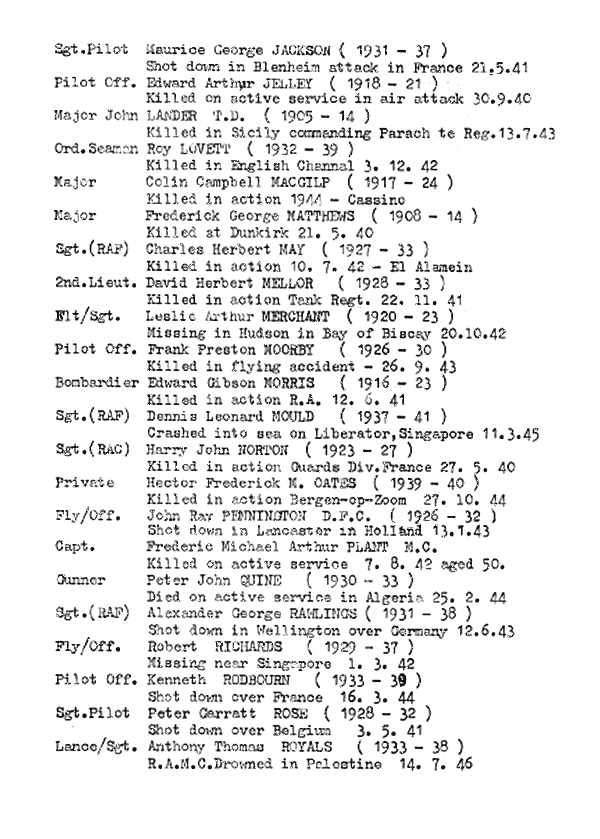
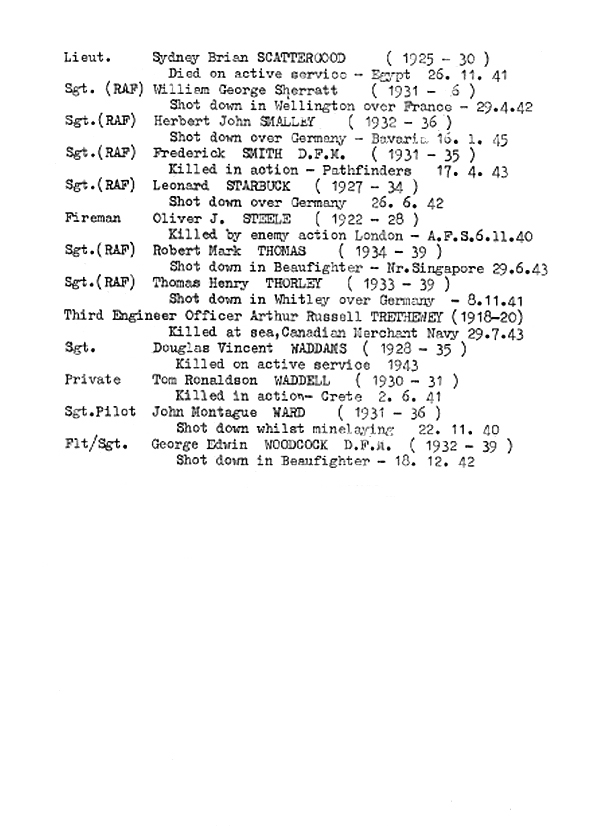

|
HEADBOYS |
|||
| 1930/31 | Fairhead | 1954/55 | G.D. Evans |
| 1932/33 | A.L. Burgess | 1955/56 | R. Johnson |
| 1933/34 | S. Dagley | 1956/57 | R.E. Gadsby |
| 1934/35 | G.R. Brotherhood | 1957/58 | T.A. Bentley |
| 1935/36 | F.E. Shotton | 1958/59 | D.J. Shrubbs |
| 1936/37 | C.H. Stevens | 1959/60 | A.R. Gadsby |
| 1937/38 | E.W. Sudale (?) | 1960/61 | M.P. Tracy |
| 1938/39 | K.L. Neal | 1961/62 | J. Parker |
| 1939/41 | D.W Johnston | 1962/63 | T.J. Hill |
| 1941/42 | E.N. Shooter | 1963/64 | J.D. Watson |
| 1942/43 | J.L. Rose | 1964/65 | R.E. Somekh |
| 1943/44 | D.J. Tomlinson | 1965/66 | A.G. Cure |
| 1944/45 | P.R. Ellis | 1966/67 | J.E. Hutt |
| 1945/46 | R. Pryce | 1967/68 | J.H. Bisbrowne |
| 1946/47 | C.G. Morris | 1968/69 | K.W. Hall |
| 1947/48 | D.J. Collington | 1969/70 | D.C. Bauer |
| 1948/49 | H.M. Richmond | 1970/71 | C.M. Beard |
| 1949/50 | H.M. Richmond, D.J. Grimsley | 1971/72 | C.M. Beard |
| 1950/51 | D. Britton, | 1972/73 | D.W.G. Henton |
| 1951/52 | K.W. Arnold | 1973/74 | G.D. Staley |
| 1952/53 | J.E. Hancock | 1974/75 | R. Yates |
| 1953/54 | R.G. Keightley | ||

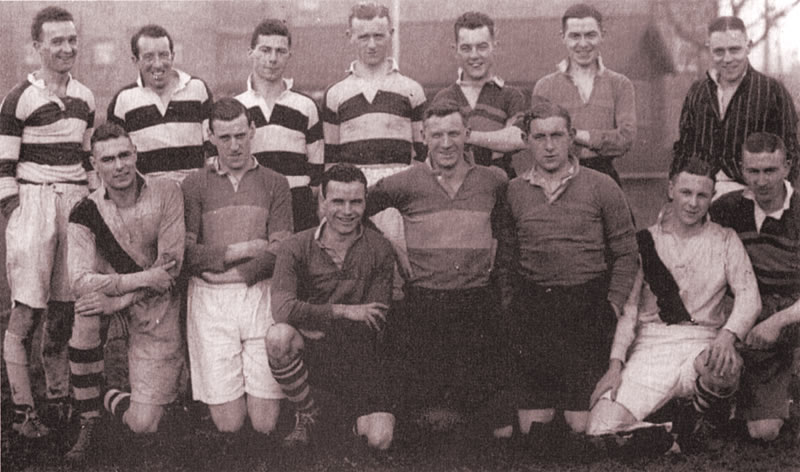
In December 1931, a team of old boys played the Burton Grammar School 1st XV on the memorial ground at Peel Croft.
Back Row: Dai Davies, Vernon, Moore, Ben Ward, John Hipwell, ‘Tuf’ Williams, Arthur Kirby, Stan Ife
Front Row: Bert Sorton, McLennon, Ron Kenning, Rupert Sims, Charlie Smith, Jack Burdett, Stan Snead

 Until the late nineteen twenties, it was Natural History taught by the greying and kindly Mr Storer who lived handily in a large house at the Bond Street end of High Street. Appropriate to his subject but not to the man was the nickname ‘Pongo’. Lessons seemed to be in the late afternoon in the draughty classroom/laboratory on the first floor beyond the Masters’ common-room. The wind rattled the dark blinds and, by the blackboard, hung a roll-down picture of the ‘Corvidae’; the group of birds that contains the crows, ravens, rooks, jackdaws, jays, magpies, treepies, choughs and nutcrackers. On this a large rook presided over the lesson as did the portrait of John Jervis, Admiral Lord St. Vincent at the head of the stairs outside. The textbook was an impenetrable work by Stenhouse and, like the Corvidae, it was seldom referred to in the lessons. We were encouraged to report the various wonders we had seen, or imagined we had seen, like white blackbirds and unusual nesting sites – a selection would later be published in ‘The Cygnet’.
Until the late nineteen twenties, it was Natural History taught by the greying and kindly Mr Storer who lived handily in a large house at the Bond Street end of High Street. Appropriate to his subject but not to the man was the nickname ‘Pongo’. Lessons seemed to be in the late afternoon in the draughty classroom/laboratory on the first floor beyond the Masters’ common-room. The wind rattled the dark blinds and, by the blackboard, hung a roll-down picture of the ‘Corvidae’; the group of birds that contains the crows, ravens, rooks, jackdaws, jays, magpies, treepies, choughs and nutcrackers. On this a large rook presided over the lesson as did the portrait of John Jervis, Admiral Lord St. Vincent at the head of the stairs outside. The textbook was an impenetrable work by Stenhouse and, like the Corvidae, it was seldom referred to in the lessons. We were encouraged to report the various wonders we had seen, or imagined we had seen, like white blackbirds and unusual nesting sites – a selection would later be published in ‘The Cygnet’.
Mr Storer had also assembled much of the collection that used to reside in the cabinets leading to the Biology lab at Bond Street.
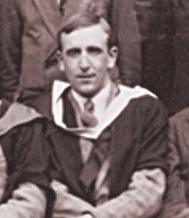 Then suddenly Mr Storer disappeared, the subject became Biology and the teacher a young Cambridge graduate, R G Neill (pictured), fresh from research work at the Plymouth Marine Biology Station (and, I believe, free also from the ‘benefits’ of teacher training). Soon the Corvidae and the white blackbirds were replaced by the different sources of evidence for Evolution and the latest chemistry of Photosynthesis. The genetics of Drosophila were just being explained in terms of genes and chromosomes. Sturtevant, one of the American researchers came to England on a lecturing visit and somehow we got specimens of the fruit-flies and tried to repeat some of his work, feeding the tiny insects on a banana mixture in jam jars.
Then suddenly Mr Storer disappeared, the subject became Biology and the teacher a young Cambridge graduate, R G Neill (pictured), fresh from research work at the Plymouth Marine Biology Station (and, I believe, free also from the ‘benefits’ of teacher training). Soon the Corvidae and the white blackbirds were replaced by the different sources of evidence for Evolution and the latest chemistry of Photosynthesis. The genetics of Drosophila were just being explained in terms of genes and chromosomes. Sturtevant, one of the American researchers came to England on a lecturing visit and somehow we got specimens of the fruit-flies and tried to repeat some of his work, feeding the tiny insects on a banana mixture in jam jars.
Neill (‘Reggie’) had an awkward manner but his penetrating intelligence and devotion to his task made many who might come to scoff remain to learn. His lessons were soon assembled and published in his admirable ‘Aids to Biology’, a miraculous alternative to ‘Stenhouse’. His writing style was precise; he was an admirer of H L Menchen and a favourite quotation was that some claim was ‘neat, plausible and wrong’.
The ‘Biology Sixth’ particularly appreciated the clear scientific approach and his enterprising new schemes. There were weekly excursions on bicycles to Hoar Cross to take measured samples of pond life; the counts of animals were correlated with records of pH and temperature. To keep the catch we constructed a series of aquaria with an aeration tower some ten feet high for the water circulation. Another ambitious construction provided the stage which could be erected in the Hall for dramatic performances (I recall that the generous lighting we organised demanded 30 amp wiring). Mr Davies and Mr Neill collaborated in writing and producing the shows.
Some remember that ‘Reggie’ Neal’s desk in the Biology lab stood on a platform. whcih no one was allowed to step on. If they did they were told in no uncertain terms “get off my quarter deck boy.”
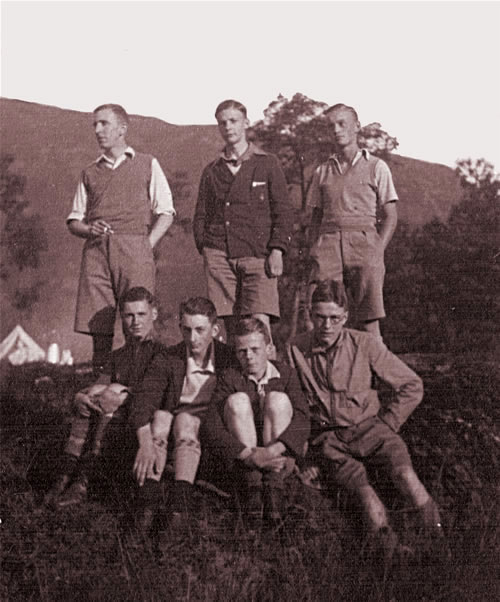 Mr Neill was also responsible for taking groups of Grammar School pupils on field trips. One such excursion was a summer cycle-camping holiday to the Lake District. This photo shows him standing with C.H. May and Frank Shotton with (left to right) James Woolley, WMN, CM and John P. Bull seated.
Mr Neill was also responsible for taking groups of Grammar School pupils on field trips. One such excursion was a summer cycle-camping holiday to the Lake District. This photo shows him standing with C.H. May and Frank Shotton with (left to right) James Woolley, WMN, CM and John P. Bull seated.
Another outstanding trip was to the Port Erin Marine Biology station in the Isle of Man. What could be a more enjoyable way to study than to row round a sunny bay and pick up samples of Sea Urchins from the clear pebbly sea floor!
Another of Neill’s literary favourites was ‘The Hunting of the Snark’ and we vied with one another to find appropriate quotations for the various adventures on our journeys – there was never any doubt as to who the ‘Bellman’ was.
Reggie Neill left the school during the war years, being replaced as Biology master during his absence by teacher from Newhall called Connie Illsley. Mr Neill returned to the school after the war.
It seemed incongruous that RGN was knowledgeable about spiritualism; we never knew whether his claim to have an aunt who levitated was just a spoof, but he turned such matters to good advantage in his historical novel ‘The Witches of Pendleton’. After marrying late in life, he retired to his beloved Lake District where he continued with success his third career as a novelist.
His first novel under the name of Robert Neill was ‘Mist over Pendle’, published in 1951. The success of this led to other novels, including ‘Moon over Scorpio’. By the time of his last book, ‘The Devil’s Door’, being published in 1979, he had sixteen books published.
Robert Neill made good contribution to the life of Burton Grammar School and to the achievements of many of its pupils. Several, such as Dr J.P. Bull C.B.E, C.H. ‘Bert’ May, whose prize giving book can be found elsewhere on the website, and Archie Grain who tragically did not survive the War; also John Woolley, Research Chemist with ICI and expert on photography and caves. His brother Jim and Noel Perks who both became teachers and Frank Shotton an Agricultural Scientist all feel endebted to Mr Neill for his influence and teaching.

In the Easter break of 1932, R.G. Neill (Biology) led a group to the Port Erin Marine Biology Station on the Isle of Man.
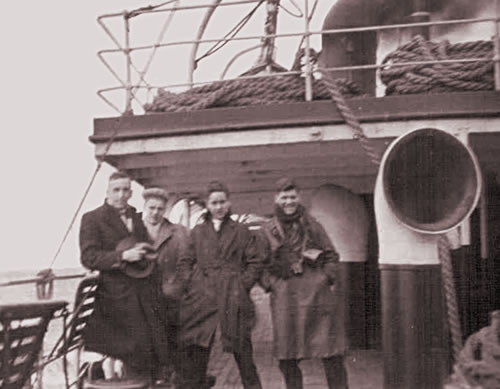
The crossing seems to be a fairly blustery crossing and shows (from left) R.G. Neill, Archie J Grain, Noel Perks and John Woolley
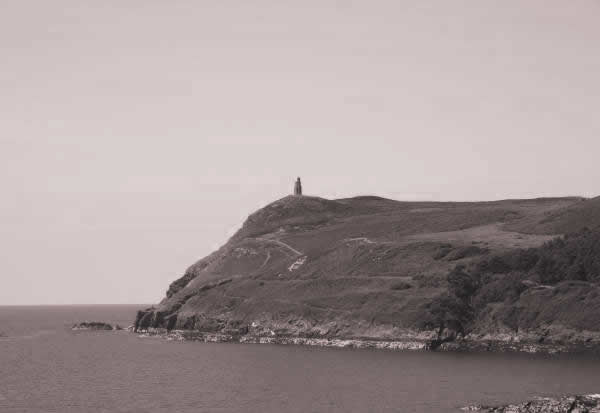
The only available picture shows the Port Erin headland.

In the summer of 1934, R.G. Neill (Biology) took a group for a cycling and camping holiday to the Lake District.
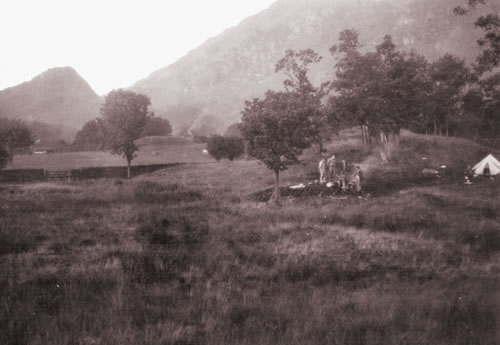
Camp at Grange

Back: R.G Neill, C.H. May, Frank Shotton,
Front: John Woolley, WMN, CM and John P. Bull
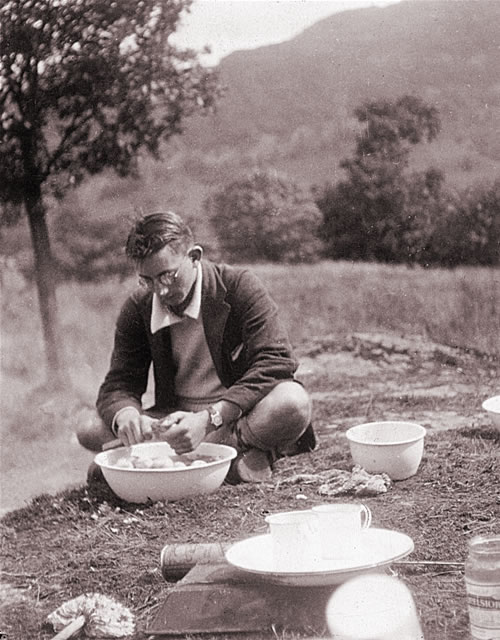
John Bull on potato peeling duty
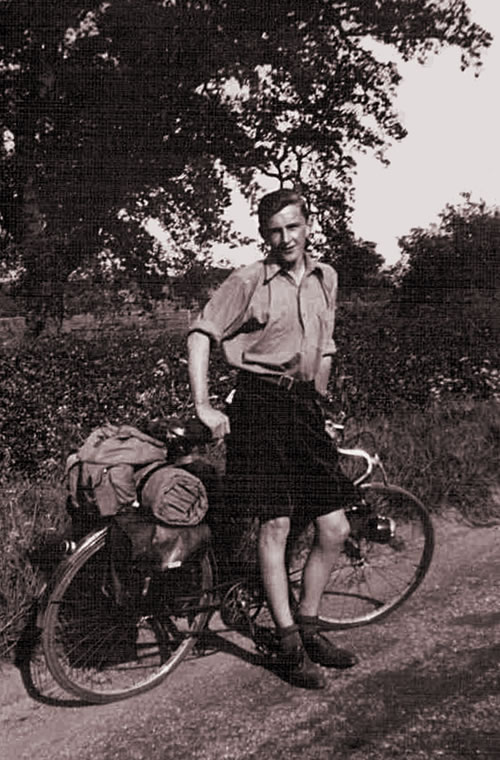
Noel Perks providing a good look at the types of bicycles used.
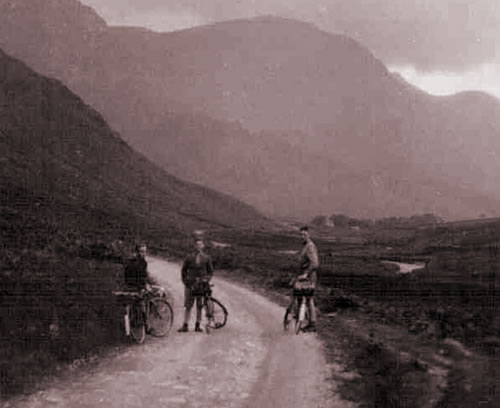
Noel Perks (Right), John Woolley (Centre) and a third member of the group pose in on one of their bike trips seen here in Honister Pass, Buttermere
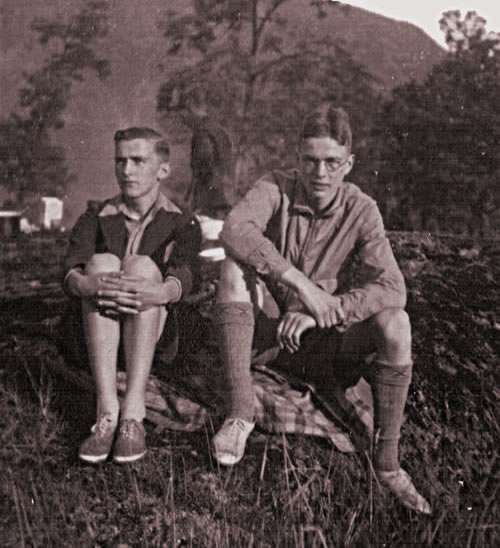
Noel Perks and John P Bull

The Woolley brothers, John and James, in their pyjamas at Borrowdale

In 1950, Raymond Crowther (Biology) took the Field Club on a camping trip to Brockenhurst in the New Forest. The trip also included the Isle of Wight
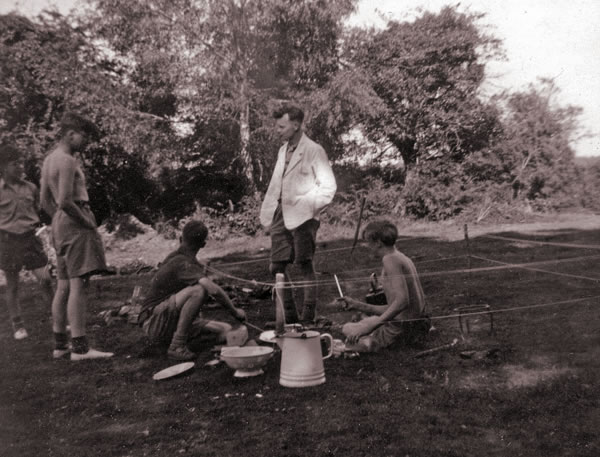
Camp, complete with camp fire, was established in the shade of a huge old oak tree near the Balmer Lawn Hotel, Brockenhurst. At far left of the picture is George Moore; the next two people are unidentified. Raymond Crowther is standing in the roped-off area and Ian Scott is seated on the ground.
The photo was taken by Mick Tanton from the position of a large fallen tree trunk that provided a convenient seating area for meals!
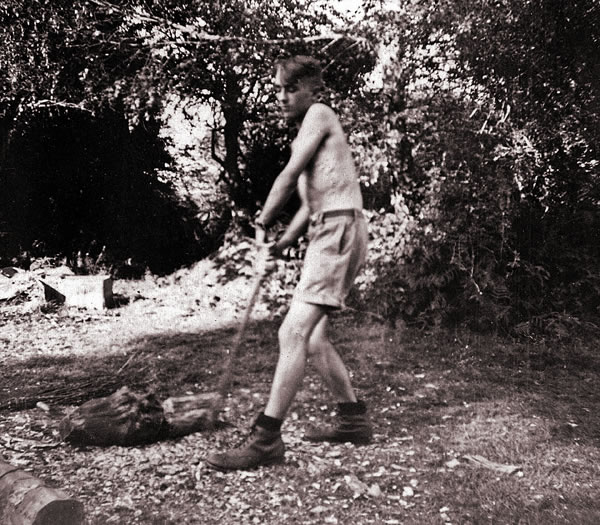
John Thompson chopping wood for the fire.
Co-incidentally, Mick Tanton met John again in the early 1960s when working at the Nature Conservancy’s Monks Wood Experimental Station between Huntingdon and Peterborough. John was the Warden for the area and lived on a cottage adjacent to the Research Station.
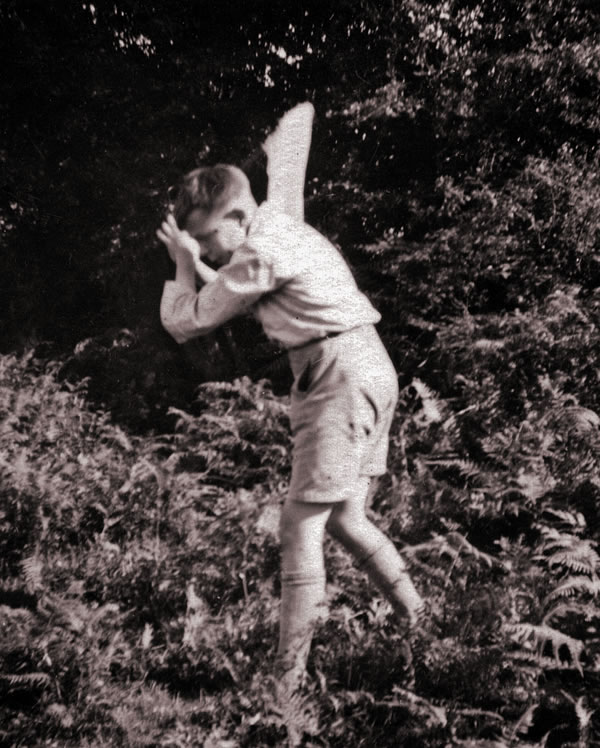
A.C. ‘Charles’ Neville in pursuit of a butterfly near camp. Both he and Mick Tanton and some of the others in the group went on to Imperial College London to study Zoology and Applied Entomology and after a Doctorate pursued successful research in insect cuticle and flight. He joined the staff of Bristol University as Mick Tanton emigrated to Australia.
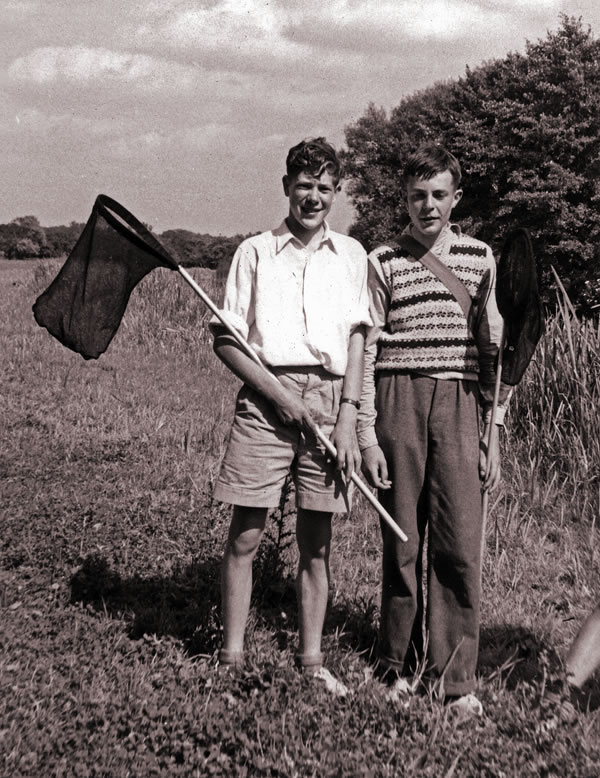
Brian Hill (left) and AC. ‘Charles’ Neville ready for a butterfly-hunting sortie. 1950 was a very hot summer and butterflies abounded in the New Forest, and as several of the group were keen entomologists, they were often our on forays.
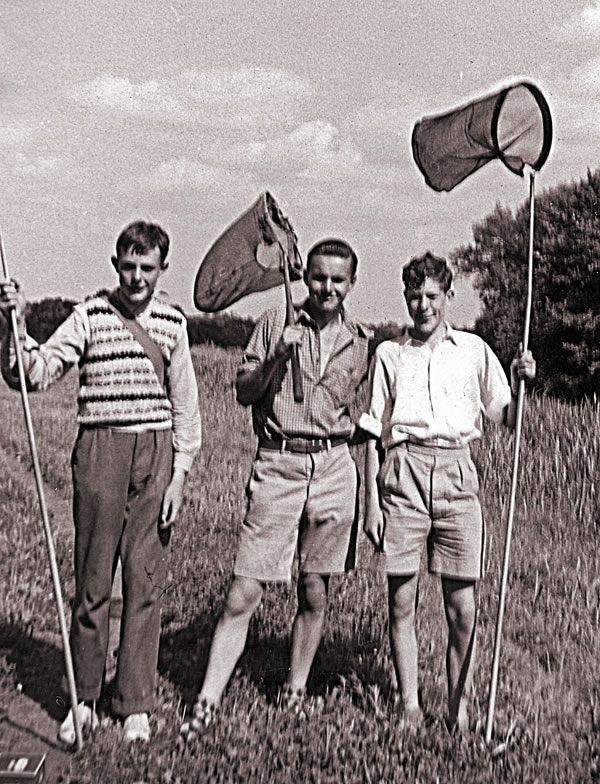
Similarly in this Photo, with Mick Tanton in the centre and Charles Neville at left.
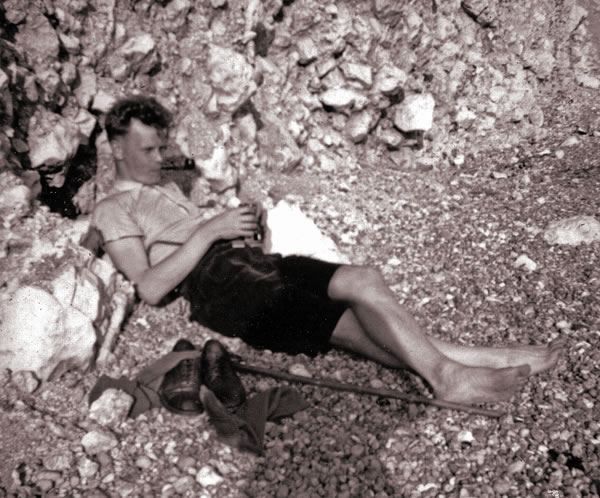
On one of the days of the two week camp Raymond Crowther took the party to the Isle of Wight. This is a trip that you could not do in the same fashion today, as they caught the train from Brockenhurst to Lymington, a line long since closed. Then it was ferry across the Solent to Cowes.
Mick Tanton cannot recall how the group got to Alum Bay at the western end of the island, but it may have been by train to Freshwater – the line was certainly in use then.
They walked across the downs and Mick remembers the myriads of Chalkhill Blue butterflies on the chalk grassland.
The group used Alum Bay for swimming, while Mr Crowther relaxed on the gravel beach.
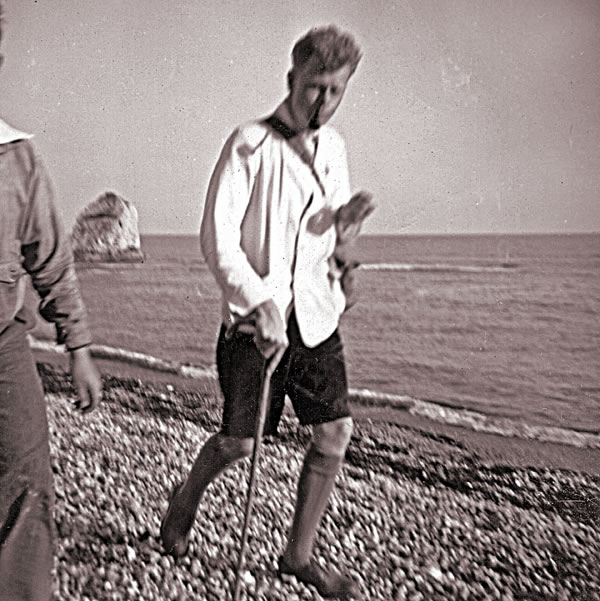
Raymond Crowther walking along the beach. Unfortunately a blurred photo because of his and my movement, but it does show his typical field garb of the time, and the shadow cast on his shoulder by his inseperable pipe is clearly visible!
